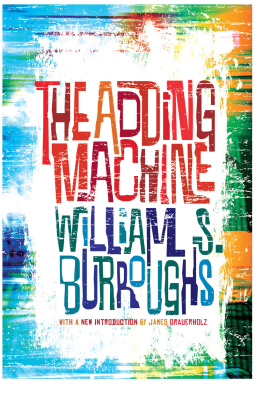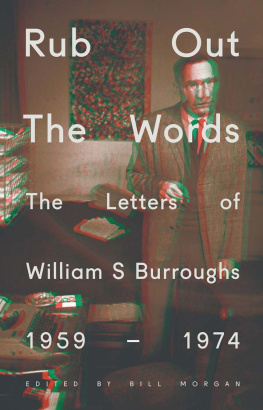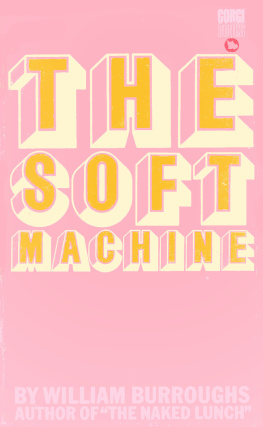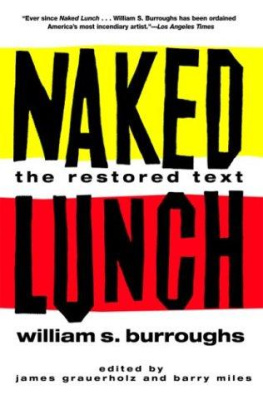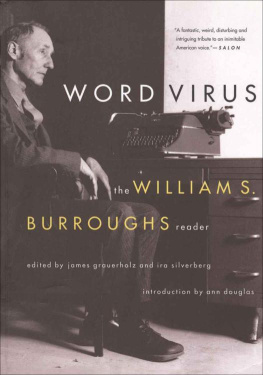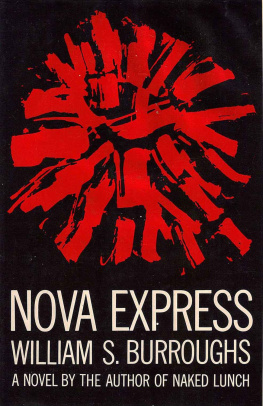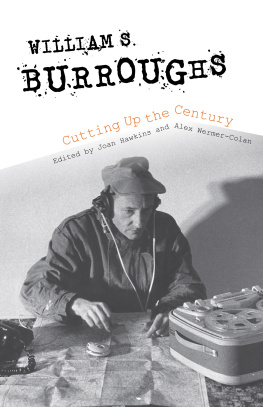THE
ADDING
MACHINE
Other Works by William S. Burroughs
Published by Grove Press
Naked Lunch
The Ticket That Exploded
The Soft Machine
Nova Express
The Wild Boys
Word Virus: The William S. Burroughs Reader
Last Words
THE
ADDING
MACHINE
Selected Essays
William S. Burroughs
Grove Press
New York
Copyright 1985, 1986 by William S. Burroughs
Introduction 2013 James Grauerholz
All rights reserved. No part of this book may be reproduced in any form or by any electronic or mechanical means, including information storage and retrieval systems, without permission in writing from the publisher, except by a reviewer, who may quote brief passages in a review. Scanning, uploading, and electronic distribution of this book or the facilitation of such without the permission of the publisher is prohibited. Please purchase only authorized electronic editions, and do not participate in or encourage electronic piracy of copyrighted materials. Your support of the authors rights is appreciated. Any member of educational institutions wishing to photocopy part or all of the work for classroom use, or anthology, should send inquiries to Grove/Atlantic, Inc., 154 West 14th Street, New York, NY 10011 or permissions@groveatlantic.com.
Originally published in Great Britain under the title The Adding Machine: Collected Essays . First published in the United States in 1986 by Seaver Books, New York, New York.
Published simultaneously in Canada
Printed in the United States of America
ISBN: 978-0-8021-2195-0
eBook ISBN: 978-0-8021-9297-4
Grove Press
an imprint of Grove/Atlantic, Inc.
154 West 14th Street
New York, NY 10011
Distributed by Publishers Group West
www.groveatlantic.com
Contents
Introduction
The Adding Machine:
Tabulating the Seventies
The title was Williams idea, off the top of his head, and I frankly did not know what to make of it:
The Adding Machine ?
We were seated at his front-room dining table in Lawrence, Kansas, with a stack of typescripts and xerocopies about three reams tall on the table in front of us, one afternoon in early 1985. His suggestion obviously referred to the Burroughs Adding Machine, perfected by his grandfather and namesake in 1894 and already world-famous by 1914, when William Seward Burroughs IImy Williamwas born. But the adding machine would fit this essays-collection... how? And was it really better than the two dozen other possible, wild titles we had been considering all afternoon?
The time had come for the sprawling essays book that William and I had been assembling for ten years to be finalized: its contents; its sequence; its title. The book had been under contract for some years to Richard Seavers Arcade Books in New York and to John Calder Books in London, but was years late in coming and now our publishers were taking it to press with stern haste. William had moved to a new literary agent, and he was soon to have new publishers in the U.S. and U.K. Thus, for Calder and Seaver, this book was the child of an awkward divorce.
In the early 1960s those two men, along with Barney Rosset at Grove Press (where Seaver was until about 1970) and Maurice Girodias at the Olympia Press in Paris, were Burroughss first publishers and literary championsnotably at the Edinburgh Festival in 1962, where Calder set the stage for the authors first critical apotheosis. They had bravely and successfully fought state censorship of the printed word in the 1960s in America and England, with Naked Lunch as one of their battering rams. After leaving Grove in the early 1970s, Dick Seaver published new Burroughs at Viking Penguin, then at Henry Holt, and finally at Arcade Press. John Calder kept pace in the U.K. The first novel of Burroughss late-life Red Night Trilogy Cities of the Red Night, in 1981had seen the warmest critical reception of any Burroughs novel since Naked Lunch.
In 1984 Burroughss oldest friend, the poet Allen Ginsberg, had joined Andrew Wylie (already our friend for ten years) at his new literary agency, and Allen urged William to come over to Wylie with him. That decision was made not lightly but definitelyand I would like to say here that neither William nor I ever regretted it for one moment. But it did result in his moving on from his earliest publishing relationships. His longtime publishers loyalty was sincere, no doubt, but was predicated perhaps on a man who William no longer was, in his life or as an artist and author.
The breakup with Dick and John was as mutually respectful as possible, and William still owed them this collection of short pieces. Now they were in no mood to indulge further editorial dithering. They each already had full copies of the texts that were stacked high on Williams table, and it was clear they were going to publish, willy-nilly. All they really wanted now was a book title.
We were making the best of a delicate situation and looking for a title to tie all these short pieces together somehow. William must have suspected the books contents were unified by the accidents of their accretion, but by little else. I remember Shotgun Wedding was one alternative title, which of course we discarded.
As the literary impact of 1959s Naked Lunch had spread across Europe and the U.S. throughout the sixties, Burroughss voice was increasingly relevant and solicited. His publishers remained committed to his next works: Nova Express (with Jonathan Cape in the U.K.), The Ticket That Exploded , and The Soft Machine . This group, now known as the Cut-Up Trilogy, and the larger multimedia experimental project of which it was a part, established that the Novel could no longer hold Burroughs. He was, moreover, becoming a public figure, often sought out for interviews by the editors of periodicals both high and low.
The judicial retreat of literary censorship in the sixties was paralleled by a remarkable rise in middle-class availability of the means of publication... and thus a piata of magazines, broadsides, newsletters, and little books poured out its candies upon the readership of the Western world. A certain messianic streak in Burroughs was egged on (and mirrored) by Brion Gysin. These interviews, opinion pieces, and short literary experiments began to serve as vehicles for Burroughss pronouncements to the culture in which he lived and worked as an artist. The essay form, normally considered marginal to a writers oeuvre, in this way played an unusually large role in Burroughss literary career and public persona.
William S. Burroughs became a cultural icon by degrees. The Burroughs mythos proximately arose, I would say, more from what was written and said about Burroughshis life, his work, and their shock-value factorsthan from what he wrote or said, in his specifically literary production. True: in his interviews, in his op-ed statements published by editorial invitation, and eventually in his columns published serially in a few periodicals, Burroughs did also say a great deal about Burroughs... but usually in a style that obscured as much as it revealed.
Viewing the entirety of what Burroughs wrote, fiction or nonfiction, his bibliographers can attest that his short, fugitive published texts number into the many hundreds. As the years pass after first publication, such works have undergone an ad hoc process of agglomeration into anthologies and collections, mostly from nonmainstream publishers such as academic presses and literary houses. The best of the serious topical materialinterviews with Burroughs, profiles and articles about him, critical evaluation of his workshas not only been prolific but is also, for the most part, now well anthologized and available to the nonspecialist.

